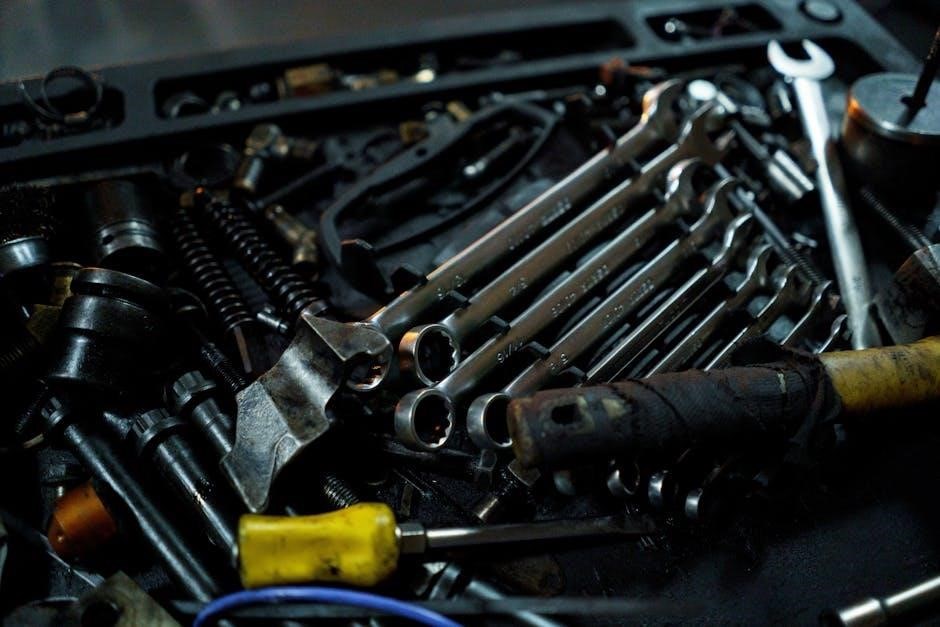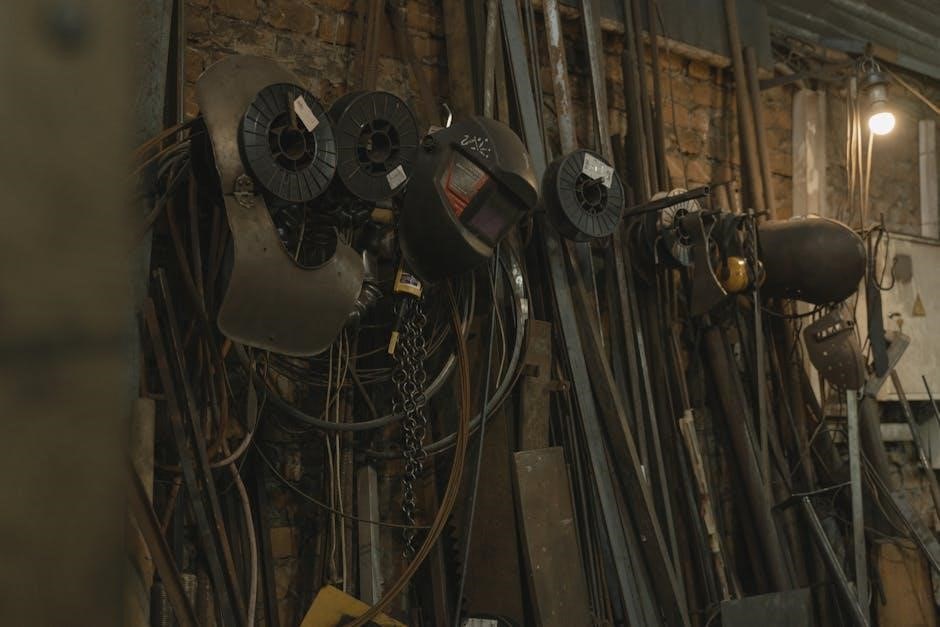mechanics of materials beer pdf
- Published
- in PDF
Mechanics of Materials explores the behavior of solids under forces․ It’s crucial for engineering design, analyzing stress, strain, and deformation․ A PDF resource offers problems on steel beams, aligning with Beer and Johnston’s authoritative textbook, a cornerstone in solid mechanics education․
1․1․ Overview of the Discipline
Mechanics of Materials is a fundamental engineering discipline that examines the behavior of solid objects under various types of forces․ It focuses on understanding stress, strain, and deformation to predict material failure and ensure structural integrity․ The discipline is rooted in classical mechanics and applies principles from mathematics and physics to analyze real-world engineering problems․ Beer and Johnston’s Mechanics of Materials is a widely recognized textbook that provides comprehensive coverage of these concepts․ Available in multiple editions, including a 7th edition, it serves as a cornerstone for students and professionals alike; The PDF versions of this text, such as Mechanics of Materials 6th Beer chapter8, offer practical problems, including the analysis of rolled steel beams under different loading conditions․ This resource is invaluable for mastering the fundamentals of solid mechanics and applying them to design and analysis tasks․
1․2․ Importance of Beer and Johnston’s Work
Beer and Johnston’s Mechanics of Materials is a seminal work in engineering education, renowned for its clear explanations and comprehensive coverage of solid mechanics․ Their textbook is widely adopted due to its ability to bridge theory and practical application, making complex concepts accessible to students․ The PDF versions of their work, such as the 6th and 7th editions, are highly sought after for their detailed problem sets, including analyses of rolled steel beams․ These resources are essential for understanding stress, strain, and deformation, crucial for designing safe and efficient structures․ The authors’ contributions have established their text as an uncontested leader in the field, ensuring its relevance across generations of engineers and educators․ Their work remains a cornerstone for both academic and professional development in mechanics of materials․
Key Concepts in Mechanics of Materials
Mechanics of Materials focuses on stress, strain, and deformation analysis․ It covers axial loads, torsion, bending, and combined loading․ The PDF includes practical problem-solving techniques․
2․1․ Stress and Strain Analysis

Stress and strain analysis forms the foundation of mechanics of materials․ Stress refers to the internal forces within a material, while strain measures the resulting deformation․ The PDF provides detailed problems and solutions for calculating stresses in rolled steel beams under various loading conditions․ These problems emphasize understanding material behavior, essential for engineering applications․ By analyzing stress distributions, engineers can predict material failure and optimize structural designs․ The concepts covered in the PDF align with Beer and Johnston’s textbook, reinforcing theoretical knowledge with practical examples․ This section is vital for students to grasp how materials respond to external forces, ensuring safe and efficient designs in real-world scenarios․
2․2․ Types of Loading and Deformation
Understanding different types of loading and deformation is critical in mechanics of materials․ The PDF resource highlights various loading conditions, such as axial, torsional, and bending loads, which cause distinct deformations in materials․ Tension and compression are fundamental types of axial loading, while torsion involves twisting forces․ Bending loads create curvature in beams, leading to flexural deformations․ The PDF also addresses thermal loads, which induce strains due to temperature changes․ These concepts, as detailed in Beer and Johnston’s textbook, are essential for analyzing material behavior under real-world conditions․ By studying these load types and their effects, engineers can design structures that withstand various forces without failure․ The problems in the PDF provide practical examples, reinforcing theoretical concepts and preparing students for complex engineering challenges․

Axial Load and Torsion
Axial loads cause tension or compression, while torsion creates twisting forces․ The PDF provides problems analyzing these effects on beams and shafts, essential for engineering design and material strength evaluation․
3․1․ Tension and Compression Analysis
Tension and compression are fundamental types of axial loads that induce normal stresses in materials․ Tension occurs when a force pulls on a material, stretching it, while compression happens when forces squeeze a material, potentially leading to buckling․ The Beer and Johnston PDF provides detailed methods for analyzing these loads, including stress calculations using the formula σ = F/A and strain analysis using ε = δ/L․ Understanding these concepts is critical for designing structural components like bars, columns, and beams․ The PDF also covers the behavior of materials under tension and compression, emphasizing the importance of yield strength and ultimate strength in determining material failure․ Practical problems in the PDF help engineers apply these principles to real-world scenarios, ensuring structural integrity and safety․
3․2․ Torsional Deformations in Shafts
Torsional deformations occur when a shaft is subjected to twisting forces, causing shear stresses and angular deformations․ The Beer and Johnston PDF provides comprehensive analysis of torsion, including the relationship between torque (T), shear stress (τ), and shear strain (γ)․ The formula τ = Tc/J is emphasized, where c is the outer radius, and J is the polar moment of inertia․ The PDF highlights the importance of understanding torsional rigidity and angular displacement in power transmission applications․ Practical examples and problems illustrate how to calculate torsional deformations in circular and non-circular shafts, ensuring engineers can design shafts to withstand torsional loads without failure․ These concepts are critical for mechanical systems involving gears, drives, and rotating machinery․

Bending and Flexure
Bending and flexure involve analyzing beams under transverse loads, causing bending moments and stresses․ The Beer and Johnston PDF explores bending moment diagrams, flexural rigidity, and deflections․

4․1․ Bending Moments and Stresses
Bending moments and stresses are critical in analyzing beams under transverse loads․ The bending moment at any section of a beam is the sum of moments caused by external forces․ Bending stress arises due to the internal resisting moment, creating tensile and compressive stresses in the beam․ The maximum bending stress occurs at the extreme fibers, calculated using the formula: σ = (M * y) / I, where M is the bending moment, y is the distance from the neutral axis, and I is the moment of inertia․ The neutral axis, where stress is zero, is vital for determining stress distribution․ Understanding bending moments and stresses is essential for designing beams to withstand loads without failure, ensuring structural integrity in engineering applications․
4․2․ Flexural Rigidity and Beam Deflections
Flexural rigidity, a measure of a beam’s stiffness, is defined as the product of the material’s modulus of elasticity (E) and the cross-sectional moment of inertia (I)․ Beam deflections occur due to external loads, with the magnitude depending on the load type, beam geometry, and support conditions․ The deflection formula, δ = (W * L³) / (3 * E * I), applies to simply supported beams with a concentrated load․ For distributed loads, integration of the bending moment equation is required․ Excessive deflections can lead to structural issues, so engineers use methods like increasing cross-sectional area or stiffeners to minimize them․ Understanding flexural rigidity and deflections is crucial for ensuring beams maintain their shape and function under various loading scenarios, as detailed in Beer and Johnston’s work․
Beam Reactions and Supports
Beam reactions are forces exerted by supports to maintain equilibrium․ Common supports include fixed, simply supported, and roller supports, each providing specific constraints․ Understanding these reactions is vital for analyzing load distribution and ensuring structural integrity․ Engineers calculate beam reactions using static equilibrium principles to determine forces at supports accurately․ This ensures safe and efficient design of beams under various loading conditions, as explained in Beer and Johnston’s mechanics of materials resources․
5․1․ Types of Beam Supports
Beam supports are critical in determining load distribution and structural behavior․ The primary types include fixed supports, which prevent both vertical and horizontal movement and rotation, roller supports, which allow horizontal movement but resist vertical loads, and pin supports, which permit rotation but restrict translation․ Additionally, simple supports provide reaction forces without restricting rotation․ Each support type has distinct applications depending on the beam’s configuration and loading conditions․ Understanding these supports is essential for accurately analyzing beam behavior, as detailed in Beer and Johnston’s mechanics of materials resources․ Proper selection ensures structural stability and safety in engineering designs․ These supports form the foundation for calculating reactions and understanding beam responses to various loads․
5․2․ Calculating Beam Reactions
Calculating beam reactions involves determining the forces and moments at supports due to applied loads․ The process typically starts with free-body diagrams to identify all forces acting on the beam․ For static equilibrium, the sum of vertical forces and moments must equal zero․ Reactions at supports are calculated using equilibrium equations, considering both vertical and horizontal components․ For simple beams, reactions can often be found by assuming one support’s reaction and solving for the other․ Distributed loads require integration, while concentrated loads simplify calculations․ Symmetry in beams can also aid in determining reactions․ Accurate calculation of beam reactions is essential for further stress and deflection analyses․ Beer and Johnston’s mechanics of materials resources provide detailed methods for solving these problems systematically․ Proper application ensures structural integrity and safety in engineering designs․

Shear Forces and Bending Moments
Shear forces and bending moments are critical in analyzing beam behavior under loads․ They represent internal forces causing deformation and potential failure in structural members․ Beer and Johnston’s mechanics of materials pdf provides foundational methods for their calculation and interpretation, ensuring safe and efficient engineering designs․ Proper understanding of these concepts is vital for predicting material response under various loading conditions․
6․1․ Shear Force Diagrams
A shear force diagram graphically represents the variation of shear force along the length of a beam․ It is plotted by calculating the shear force at various sections of the beam under given loads․ The diagram helps identify points of maximum shear force, which are critical for design purposes․ Constructing shear force diagrams involves determining beam reactions, isolating segments of the beam, and applying equilibrium principles․ The shape of the diagram depends on the type and distribution of loads, such as concentrated, distributed, or varying loads․ Beer and Johnston’s mechanics of materials pdf provides detailed methods for drawing accurate shear force diagrams, emphasizing their importance in assessing structural integrity and material selection․ Understanding shear force diagrams is essential for predicting potential failure points in beams under various loading conditions․
6․2․ Bending Moment Diagrams
A bending moment diagram illustrates the variation of bending moments along the length of a beam․ It is constructed by calculating bending moments at critical sections, such as points of load application and supports․ The diagram helps identify maximum bending moments, which are crucial for determining the required strength and stiffness of the beam․ Bending moment diagrams are typically drawn in conjunction with shear force diagrams, as they are interrelated․ The shape of the diagram depends on the beam’s supports and the type of loading․ Beer and Johnston’s mechanics of materials pdf provides comprehensive techniques for constructing bending moment diagrams, including the use of equilibrium equations and integration of shear force diagrams․ These diagrams are essential for beam design, ensuring that materials can withstand maximum bending stresses without failure․ They are widely used in structural and mechanical engineering applications․

Deflection of Beams
Beam deflection analysis determines the deformation of beams under various loads, ensuring structural integrity and serviceability․ It accounts for load types, supports, and material properties to predict maximum sag or displacement, critical for design safety and performance․
7․1․ Methods for Calculating Deflections
Deflection calculations are essential for ensuring beams behave as intended under load․ Common methods include the Double Integration approach, which integrates the bending moment equation twice to find displacement․ The Moment Area method is another technique, using the relationship between bending moments and curvature․ For complex loading conditions, singularity functions simplify integration by representing discontinuous loads․ Additionally, the energy methods, such as the unit load method, use virtual work principles to determine deflections․ These methods vary in complexity but all require precise knowledge of boundary conditions and material properties․ Accurate deflection analysis ensures structural safety and serviceability, preventing excessive sagging or vibration in beams under various load types․
7․2․ Impact of Load Types on Deflections
Load types significantly influence beam deflections, with each load application creating distinct deformation patterns․ Point loads produce localized deflections, while uniformly distributed loads cause more evenly spread bending․ Concentrated moments induce abrupt changes in curvature, leading to sharp deflection variations․ The magnitude and distribution of loads directly affect the degree of bending, with higher loads resulting in greater deflections․ Additionally, impact loads and dynamic loading can amplify deflections due to inertia effects․ Understanding the load type is crucial for accurate deflection prediction, as it determines the boundary conditions and integration of the bending moment equation․ Engineers must consider these factors to ensure beams remain within allowable deflection limits, maintaining structural integrity and functionality under varying load conditions․

Combined Loading and Material Behavior
Combined loading involves analyzing the interaction of multiple stresses, such as axial, torsional, and bending, to predict material behavior and potential failure under complex conditions․
8․1․ Combined Stresses in Materials
Combined stresses occur when materials are subjected to multiple types of loading simultaneously, such as axial, bending, and torsional stresses․ This interaction of stress components can lead to complex stress states, where principal stresses and stress trajectories play a crucial role․ Understanding these combined stresses is essential for predicting material behavior and ensuring structural integrity․ The superposition principle is often applied to analyze such scenarios, allowing engineers to determine the resultant stress distribution․ Additionally, failure theories like the von Mises and Tresca criteria are employed to evaluate whether materials can withstand combined stresses without failing․ Accurate analysis of combined stresses is critical in designing components like shafts, beams, and machine elements in mechanical systems․
8;2․ Material Failure Criteria
Material failure criteria are essential for predicting when a material will fail under combined stresses․ The Tresca criterion, also known as the maximum shear stress theory, states that failure occurs when the maximum shear stress exceeds the shear strength of the material․ The von Mises criterion, or distortional energy theory, predicts failure when the distortional energy per unit volume reaches a critical value․ Additionally, the Maximum Principal Stress criterion is used for brittle materials, where failure is expected when the principal stress exceeds the ultimate tensile strength․ These criteria are applied to multiaxial stress states to determine the safety of mechanical components․ Factors such as stress concentration, material defects, and loading conditions further influence the accuracy of these predictions, making them vital tools in engineering design to prevent material failure․

Buckling and Stability
Buckling and stability analyze structural failure under compressive loads․ Euler’s formula calculates critical loads for columns, considering material properties and geometry․ Essential for design safety․
9․1․ Euler’s Formula for Column Buckling
Euler’s formula predicts the critical load at which a slender column begins to buckle under axial compression․ The formula is given by Pcr = (π² * E * I) / L², where Pcr is the critical load, E is the modulus of elasticity, I is the moment of inertia of the cross-sectional area, and L is the effective length of the column․ This formula assumes the column is slender, the load is applied axially and centrally, and the material behaves elastically․ Euler’s formula is fundamental in structural engineering for designing columns to avoid buckling failure․ It provides a theoretical basis for determining the maximum compressive load a column can sustain without losing stability․ The formula highlights the importance of column geometry and material properties in ensuring structural integrity․
9․2․ Factors Influencing Buckling
Several factors influence the buckling behavior of columns, including geometry, material properties, and boundary conditions․ The slenderness ratio, defined as the ratio of the column’s length to its radius of gyration, is critical, as longer and slender columns are more prone to buckling․ The modulus of elasticity and yield strength of the material also play significant roles․ Boundary conditions, such as fixed, pinned, or free ends, affect the critical load․ Imperfections like initial curvature or eccentric loading can reduce the buckling load․ Additionally, residual stresses and non-uniform cross-sectional properties can influence stability․ These factors must be considered in design to ensure columns can withstand expected loads without failing․ Understanding these influences is essential for safe and efficient structural design, as outlined in mechanics of materials resources like Beer and Johnston’s work․

Solution Techniques and Resources
Common solution techniques include equilibrium principles, energy methods, and beam theory․ Resources like Beer and Johnston’s Mechanics of Materials PDF provide detailed examples and formulas for analysis․
10․1․ Engineering Problem-Solving Strategies
Effective problem-solving in mechanics of materials involves a systematic approach: define the problem, sketch the scenario, and identify knowns and unknowns․ Free-body diagrams and equations of equilibrium are essential tools for analyzing forces and stresses․ Apply fundamental principles like Hooke’s Law and stress-strain relationships to relate loads to deformations․ Verify solutions by checking dimensional consistency and comparing with expected behaviors․ Iteration is key—refine assumptions and calculations as needed․ Students often benefit from practicing with examples from textbooks like Beer and Johnston’s Mechanics of Materials PDF, which provides clear methodologies and practical applications․ Developing a thorough understanding of these strategies enhances engineering judgment and accuracy in solving complex material behavior problems․
10․2․ Accessing Mechanics of Materials PDF Resources
Accessing the Mechanics of Materials PDF by Beer and Johnston is straightforward through various academic platforms․ Many universities provide access via their libraries or online learning systems․ Additionally, eBook platforms like Pearson, Amazon, or Google Books offer digital versions for purchase or rental․ Some websites may offer free PDF downloads, though users should ensure they comply with copyright laws․ The PDF includes detailed chapters, example problems, and diagrams that aid in understanding complex concepts․ Students often supplement their studies with the accompanying solution manual for additional practice․ Utilizing these resources effectively enhances comprehension of stress analysis, beam deflections, and material behavior, making them indispensable for engineering students and professionals alike․
